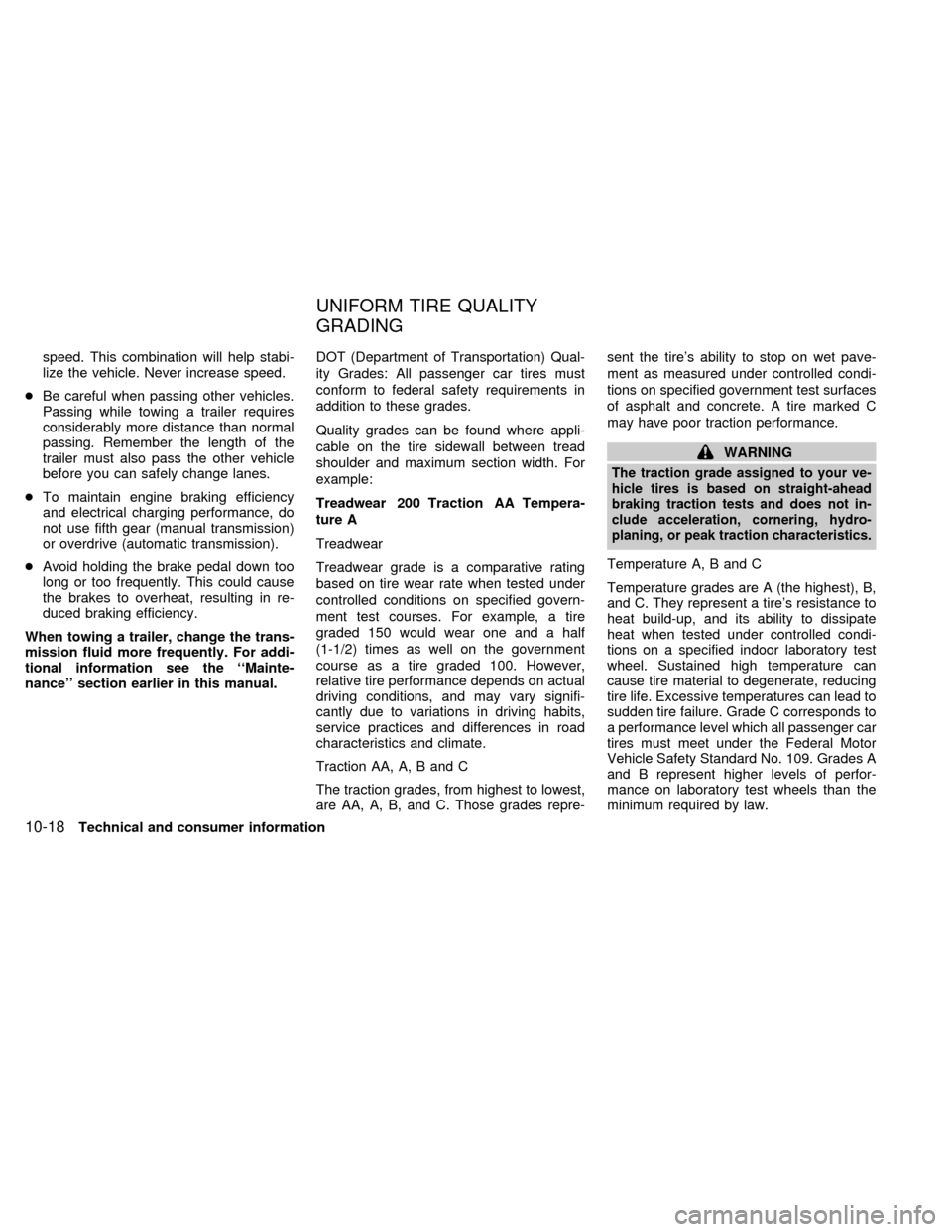2000 NISSAN ALTIMA tires
[x] Cancel search: tiresPage 204 of 242

Tires* ÐCheck the pressure with a gauge
periodically when at a service station, in-
cluding the spare, and adjust to the speci-
fied pressure if necessary. Check carefully
for damage, cuts or excessive wear.
Wheel nuts* ÐWhen checking the tires,
make sure no wheel nuts are missing, and
check for any loose wheel nuts. Tighten if
necessary.
Tire rotation* ÐTires should be rotated
every 7,500 miles (12,000 km).
Wheel alignment and balance ÐIf the
vehicle should pull to either side while driv-
ing on a straight and level road, or if you
detect uneven or abnormal tire wear, there
may be a need for a wheel alignment.
If the steering wheel or seat vibrates at
normal highway speeds, wheel balancing
may be needed.Windshield wiper blades* ÐCheck for
cracks or wear if they do not wipe properly.
Doors and engine hood ÐCheck that all
doors and the hood operate properly. Also
ensure all latches lock securely. Lubricate
hinges, latches, rollers and links if neces-
sary. Make sure the secondary latch keeps
the hood from opening when the primary
latch is released.
When driving in areas using road salt or
other corrosive materials, check lubrication
frequently.
Lights* ÐMake sure the headlights, stop
lights, tail lights, turn signal lights, and other
lights are all operating properly and installed
securely. Also check headlight aim.
INTERIOR MAINTENANCE
The maintenance items listed here should
be checked on a regular basis, such as
when performing periodic maintenance,
cleaning the vehicle, etc.
Additional information on the following
items with an ``*'' is found in the ``Do-it-
yourself'' section of this manual.Warning lights and chimes ÐMake sure
all warning lights and buzzers/chimes are
operating properly.
Windshield wiper and washer* ÐCheck
that the wipers and washer operate properly
and that the wipers do not streak.
Windshield defroster ÐCheck that the air
comes out of the defroster outlets properly
and in sufficient quantity when operating the
heater or air conditioner.
Steering wheel ÐCheck for changes in
the steering conditions, such as excessive
freeplay, hard steering or strange noises.
Seats ÐCheck seat position controls such
as seat adjusters, seatback recliner, etc. to
ensure they operate smoothly and all
latches lock securely in every position.
Check that the head restraints move up and
down smoothly and the locks (if so
equipped) hold securely in all latched posi-
tions.
Seat belts ÐCheck that all parts of the seat
belt system (for example, buckles, anchors,
adjusters and retractors) operate properly
and smoothly, and are installed securely.
Check the belt webbing for cuts, fraying,
wear or damage.
Maintenance
9-3
ZX
Page 214 of 242

10 Technical and consumer information
Capacities and recommended fuel/lubricants ......10-2
Fuel recommendation...........................................10-3
Engine oil and oil filter recommendation..............10-5
Recommended SAE viscosity number.................10-6
Air conditioner system refrigerant and
lubricant recommendations ..................................10-7
Specifications .......................................................10-8
Engine ..................................................................10-8
Wheels and tires ..................................................10-9
Dimensions and weights ......................................10-9
When traveling or registering your vehicle in
another country ..................................................10-10
Vehicle identification ..........................................10-10
Vehicle identification number (VIN) plate...........10-10
Vehicle identification number
(chassis number) ................................................10-10
Engine serial number .........................................10-11
F.M.V.S.S. certification label ..............................10-11
Emission control information label .....................10-12Tire placard ........................................................10-12
Air conditioner specification label.......................10-12
Installing front license plate................................10-13
Vehicle loading information ................................10-13
Terms .................................................................10-13
Determining vehicle load capacity .....................10-14
Loading tips ........................................................10-14
Towing a trailer...................................................10-15
Maximum load limits...........................................10-15
Towing load/specification chart ..........................10-16
Towing safety .....................................................10-16
Uniform tire quality grading ................................10-18
Emission control system warranty .....................10-19
Reporting safety defects (US only) ....................10-19
Readiness for inspection/maintenance (I/M)
test (US only) .....................................................10-20
Owner's manual/service manual order
information ..........................................................10-21
ZX
Page 222 of 242

WHEELS AND TIRES
Conventional T type (Spare)
Road wheel
Steel XE, GXE 15 x 6JJ 15 x 4T
Aluminum
SE, GLE, GXE
(1)16 x 6JJ 15 x 4T
Offset in (mm) 1.77 (45) 1.57 (40)
Tire size XE P195/65R15
GXE P205/60R15T
GXE, GLE P205/55R16T T125/70D15
SE P205/55R16H
(1) if so equipped
DIMENSIONS AND WEIGHTS
Overall length in (mm) 185.7 (4,717)
Overall width in (mm) 69.1 (1,754)
Overall height in (mm) 55.9 (1,420)
Front tread in (mm) 59.3 (1,505)
Rear tread in (mm) 58.9 (1,495)
Wheelbase in (mm) 103.1 (2,620)
Gross vehicle weight rating lb (kg)
See the ``F.M.V.S.S.
certification label'' on
the driver side, center
door pillar. Gross axle weight rating
Front lb (kg)
Rear lb (kg)
Technical and consumer information10-9
ZX
Page 229 of 242

hitch, trailer tongue load and any other
optional equipment. In addition, front or rear
gross axle weight must not exceed the
gross axle weight rating (GAWR) shown on
the F.M.V.S.S. certification label.
TOWING LOAD/SPECIFICATION
CHART
UNIT: lb (kg)
MAXIMUM
TOWING LOAD1,000 (454)
MAXIMUM
TONGUE LOAD110 (49)
TOWING SAFETY
Trailer hitch
Choose a proper hitch for your vehicle and
trailer. A genuine NISSAN trailer hitch is
available from your NISSAN dealer
(Canada only). Make sure the trailer hitch is
securely attached to the vehicle, to help
avoid personal injury or property damage
due to sway caused by crosswinds, rough
road surfaces or passing trucks.
CAUTION
cDo not use axle-mounted hitches.
cThe hitch should not be attached to
or affect the operation of the impact-
absorbing bumper.
cDo not modify the vehicle exhaust
system, brake system, etc. to install
a trailer hitch.
cTo reduce the possibility of addi-
tional damage if your vehicle is
struck from the rear, where practical,
remove the hitch and/or receiver
when not in use.
cAfter the hitch is removed, seal the
bolt holes to prevent exhaust fumes,
water or dust from entering the pas-
senger compartment.
cRegularly check that all hitch mount-
ing bolts are securely mounted.
Tire pressures
cWhen towing a trailer, inflate the vehicle
tires to the recommended cold tire pres-
sure indicated on the tire placard (affixed
to the driver's door, center pillar).cTrailer tire condition, size, load rating and
proper inflation pressure should be in
accordance with the trailer and tire
manufacturer's specifications.
Safety chains
Always use suitable chains between your
vehicle and the trailer. Safety chains should
be crossed and should be attached to the
hitch, not to the vehicle bumper or axle. Be
sure to leave enough slack in the chains to
permit turning corners.
Trailer lights
Trailer lights should comply with federal
and/ or local regulations. When wiring the
vehicle for towing, connect the stop and tail
light pickup into the vehicle electrical circuit.
Trailer brakes
If your trailer is equipped with a braking
system, make sure it conforms to Federal
and/or local regulations and that it is prop-
erly installed.
10-16Technical and consumer information
ZX
Page 231 of 242

speed. This combination will help stabi-
lize the vehicle. Never increase speed.
cBe careful when passing other vehicles.
Passing while towing a trailer requires
considerably more distance than normal
passing. Remember the length of the
trailer must also pass the other vehicle
before you can safely change lanes.
cTo maintain engine braking efficiency
and electrical charging performance, do
not use fifth gear (manual transmission)
or overdrive (automatic transmission).
cAvoid holding the brake pedal down too
long or too frequently. This could cause
the brakes to overheat, resulting in re-
duced braking efficiency.
When towing a trailer, change the trans-
mission fluid more frequently. For addi-
tional information see the ``Mainte-
nance'' section earlier in this manual.DOT (Department of Transportation) Qual-
ity Grades: All passenger car tires must
conform to federal safety requirements in
addition to these grades.
Quality grades can be found where appli-
cable on the tire sidewall between tread
shoulder and maximum section width. For
example:
Treadwear 200 Traction AA Tempera-
ture A
Treadwear
Treadwear grade is a comparative rating
based on tire wear rate when tested under
controlled conditions on specified govern-
ment test courses. For example, a tire
graded 150 would wear one and a half
(1-1/2) times as well on the government
course as a tire graded 100. However,
relative tire performance depends on actual
driving conditions, and may vary signifi-
cantly due to variations in driving habits,
service practices and differences in road
characteristics and climate.
Traction AA, A, B and C
The traction grades, from highest to lowest,
are AA, A, B, and C. Those grades repre-sent the tire's ability to stop on wet pave-
ment as measured under controlled condi-
tions on specified government test surfaces
of asphalt and concrete. A tire marked C
may have poor traction performance.
WARNING
The traction grade assigned to your ve-
hicle tires is based on straight-ahead
braking traction tests and does not in-
clude acceleration, cornering, hydro-
planing, or peak traction characteristics.
Temperature A, B and C
Temperature grades are A (the highest), B,
and C. They represent a tire's resistance to
heat build-up, and its ability to dissipate
heat when tested under controlled condi-
tions on a specified indoor laboratory test
wheel. Sustained high temperature can
cause tire material to degenerate, reducing
tire life. Excessive temperatures can lead to
sudden tire failure. Grade C corresponds to
a performance level which all passenger car
tires must meet under the Federal Motor
Vehicle Safety Standard No. 109. Grades A
and B represent higher levels of perfor-
mance on laboratory test wheels than the
minimum required by law.
UNIFORM TIRE QUALITY
GRADING
10-18Technical and consumer information
ZX
Page 240 of 242

Self-adjusting brakes ................................. 8-20
Servicing air conditioner .............................. 4-9
Shift lock release ....................................... 5-10
Shifting
Automatic transmission .......................... 5-9
Manual transmission............................. 5-12
Shoulder belt height adjustment ................ 1-27
Spark plug replacement............................. 8-15
Speedometer ............................................... 2-3
Spotlights (See map light) ......................... 2-29
SRS warning label ..................................... 1-19
Starting
Before starting the engine ...................... 5-6
Jump starting................................. 6-8, 8-15
Precautions when starting and driving ... 5-2
Push starting......................................... 6-10
Starting the engine ................................. 5-7
Steering
Power steering fluid .............................. 8-12
Power steering system ......................... 5-18
Tilting steering wheel............................ 3-13
Stop light .................................................... 8-33
Storage ...................................................... 2-21
Sunroof ...................................................... 2-27
Supplemental restraint system
Information and warning labels ............ 1-19
Supplemental restraint system
(Supplemental air bag system).................... 1-9
Switch
Automatic power window switch .......... 2-27
Front fog light switch ............................ 2-18Hazard warning flasher switch ............. 2-18
Headlight and turn signal switch .......... 2-16
Ignition switch ......................................... 5-4
Overdrive switch ................................... 5-11
Rear window defogger switch .............. 2-15
Windshield wiper and washer switch ... 2-14
T
Tachometer .................................................. 2-4
Theft warning (see enhanced immobilizer
security system) ......................................... 2-10
Three-way catalyst....................................... 5-2
Tilting steering wheel ................................. 3-13
Tire
Flat tire.................................................... 6-2
Spare tire....................................... 6-7, 8-37
Tire chains ............................................ 8-35
Tire placard......................................... 10-12
Tire pressure ............................. 10-16, 8-34
Tire rotation .......................................... 8-36
Types of tires ........................................ 8-34
Uniform tire quality grading ................ 10-18
Wheels and tires................................... 8-34
Wheel/tire size ...................................... 10-9
Towing
Tow truck towing .................................. 6-11
Towing load/specification chart .......... 10-16
Trailer towing ...................................... 10-15
Transmission
Automatic transmission fluid (ATF) ...... 8-10Driving with automatic transmission ....... 5-4
Driving with manual transmission ........... 5-5
Selector lever lock release ................... 5-10
Travel (See registering your vehicle in
another country)....................................... 10-10
Trip odometer .............................................. 2-3
Trunk access through the rear seat ............ 1-6
Trunk lid lock opener lever ........................ 3-10
Trunk light .................................................. 2-30
Trunk side net ............................................ 2-26
Turn signal switch (See headlight and turn
signal switch) .................................... 2-16, 2-17
U
Uniform tire quality grading ..................... 10-18
V
Vanity mirror .............................................. 3-13
Vehicle dimensions and weights ............... 10-9
Vehicle identification ................................ 10-10
Vehicle identification number (VIN)
(chassis number) ..................................... 10-10
Vehicle identification number (VIN)
plate ......................................................... 10-10
Vehicle loading information ..................... 10-13
Vehicle recovery ........................................ 6-13
Ventilators .................................................... 4-2
11-5
ZX
Page 241 of 242

W
Warning
Air bag warning light ............ 1-14, 1-19, 2-7
Hazard warning flasher switch ............. 2-18
Warning labels (for SRS) ..................... 1-19
Warning/indicator lights and chimes ...... 2-6
Weights (See dimensions and weights) .... 10-9
Wheels and tires ........................................ 8-34
Wheel/tire size ........................................... 10-9
When traveling or registering your vehicle
in another country .................................... 10-10
Window washer fluid.................................. 8-13
Windows
Locking passengers' windows .............. 2-27
Power windows..................................... 2-26
Windshield wiper and washer switch ........ 2-14
Wiper
Windshield wiper and washer switch ... 2-14
Wiper blades......................................... 8-18
11-6
ZX